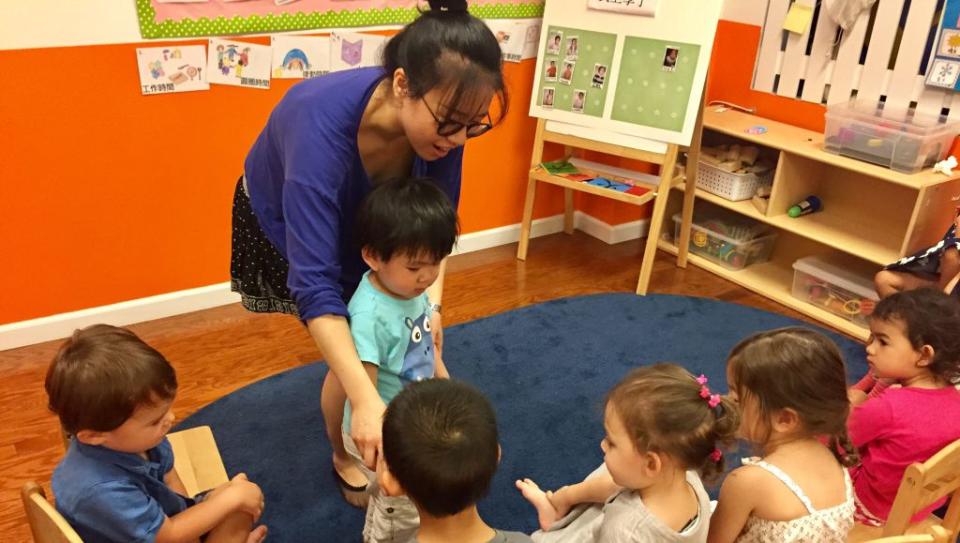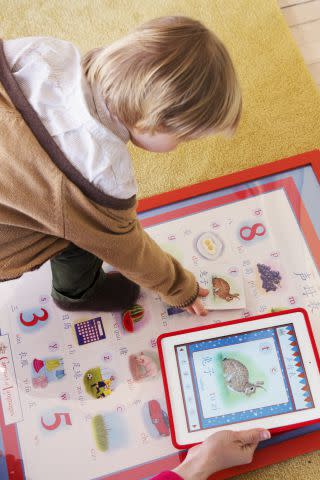Teach your kids Mandarin the Jared and Ivanka way, for $75,000 and up a year

When Ivanka Trump’s 5-year-old daughter Arabella Kushner serenaded visiting Chinese president Xi Jinping with a Mandarin folk song earlier this month, it prompted an outpouring of affection from many in China. In America, it probably prompted at least a little envy among other parents of young Mandarin learners.
President Donald Trump may be known for his threats to knock China down a peg or two, but his grandchildren are part of growing desire among American families to help their kids take advantage of China’s global rise—with Mandarin skills.
It’s an effort that has the support of both the US and Chinese governments, and has created jobs in the US for Chinese teachers like 27-year-old Jing Yongtai, from eastern China’s Zhejiang province.
Starting them young

Jing loves kids and cooking.
Jing came to the US in 2008 for a bachelor’s in childhood education. After completing her degree and passing New York State’s teacher certification exam, she began working at the private Carousel of Languages school in Manhattan. There she tutored Ivanka Trump’s two older children for about a year, between 2014 and 2015. (Quartz sought comment from Ivanka Trump and will update if we receive a response.)
Carousel bills itself as New York City’s “premiere foreign language program for young children.” Twelve one-hour weekly classroom sessions, limited to no more than five children, run nearly $800. Patrizia Corman, the school’s founder, said that children from many “influential families” are enrolled in their programs. She confirmed that all three of Ivanka Trump and Jared Kushner’s children—Arabella, Joseph, now three, and one-year-old Theodore—have attended Mandarin classes at her institution “multiple times a week.”
“A very admirable family,” she said in an email to Quartz, without elaborating on their classroom sessions.
Perhaps the main thing that distinguishes Mandarin learning in wealthier families is the ability to start very young. In contrast, while US public schools have begun to offer Mandarin much earlier than in the past, it’s likely exposure wouldn’t begin before elementary or middle school. Jing said that Arabella was three years old when she first taught her in the summer of 2014, while her younger brother Joseph was not yet a year. Education experts say you have to start very young, when the brain is most malleable, for a shot at being truly bilingual.
In fact, formal tutoring wasn’t the kids’ only (or even first) exposure to the language, as a recently posted Instagram photo of Theodore showed.
A Mandarin-speaking nanny
Jing remembers that although Joseph, the middle child, wasn’t really speaking when he attended her one-hour weekly class, those words he could utter were in Mandarin. That’s mainly thanks their Mandarin-speaking nanny, Xixi.
Ivanka Trump asks the nanny to let her kids “learn new things every day.” In a 2012 interview with Hong Kong’s South China Morning Post, Ivanka Trump said that she had an “incredible” Chinese nanny who was teaching her daughter. “My daughter doesn’t speak much yet,” she said of a one-year-old Arabella, “but she seems to know as many words in Mandarin in terms of understanding what they mean as she does in English.” Jing added that the nanny told her that Ivanka Trump wants the kids to “learn new things every day.”
Ivanka Trump’s Instagram offers some clues to what her kids learned at home. When Arabella was three-and-a-half, her mother posted a video of her reciting the popular Chinese nursery rhyme “The little white rabbit is so white.” In celebration of the 2015 Lunar New Year, Arabella was seen in a video dressed in the lucky color red, reciting ancient poems about peasants and geese. This year, her pronunciation had noticeably improved as she sang a Chinese song celebrating the new year.
During Xi’s visit, the children also recited from Sanzijing, or the “Three Character Classic,” a controversial book that was long banned in China for advocating feudal thinking.
A live-in nanny might be vital for bilingual learning, but isn’t possible for most families. Such a nanny can likely command a six-figure salary, and even a live-out nanny would be unlikely to be available for much less than $50,000 a year, not counting benefits and overtime.
Jing recommends, in that case, that families who want their kids to be fluent in Chinese try to give them at least 20 hours of language exposure a week. That might seem like a lot, but they need it to get a good foundation before they enter formal schooling, when they will be immersed in an English-language environment, and other acquired languages take a step back.
Immerse like the first family (and other elite kids)
In immersion language learning, which is what Carousel uses, the teacher interacts only in Mandarin and uses other cues to help students figure out the meaning, mimicking the way kids pick up speech. That differs from instructing in English and focusing on grammar rules.
Corman, of Carousel, said what also sets her program apart is the proprietary teaching materials and tools, “which are of the highest quality.” “Our illustrator, in France, has been designing our themes for over 13 years,” she adds.

Carousel’s Chinese teaching materials.
Arabella’s curriculum at Carousel included songs, conversations, role-play, and story puzzles, which require kids to put pieces together in a logical order to create a story, said Jing. Picture cards, puppets, and playacting are particularly useful in language teaching for children. When she was taught the story of Goldilocks and the Three Bears in Mandarin, Jing said, Arabella was so enthusiastic that she asked to play each character once.
Jing has since left Carousel and, with a partner, opened her own Manhattan school in January catering to elite preschoolers. There she developed her own program, with another trendy focus.
The program combines Mandarin with STEM education, which stands for science, technology, engineering, and math. For example, Jing teaches kids—in Mandarin—how to build remote-controlled robot toys. A dozen kids from 2 to 6 years of age attend the program, which charges nearly $2,000 per month for weekday all-day classes. (In most US states, kids enter first grade at age 7.)
Very young students can sometimes get overexcited, Jing noted. She prefers to call a time out when a child is making it hard for other kids to carry on with an activity. Kids often throw tantrums in response, but Arabella was a “rare exception,” Jing said, usually quietly sitting aside for a while and then coming back to say, “I think I’m ready.”
“One Million Strong”
In recent years, the US, with some help from China, has been trying to level the playing field so that even students whose families don’t have a lot of resources have a chance to learn Mandarin.
“If our countries are going to do more together around the world, then speaking each other’s language… is a good place to start.” In 2015 the US government initiated a national program to have one million American students from kindergarten to 12th grade (K-12) learn Mandarin in five years. “If our countries are going to do more together around the world, then speaking each other’s language, truly understanding each other, is a good place to start,” said then president Barack Obama when announcing the campaign with his Chinese counterpart, Xi Jinping.
An estimated 400,000 American K-12 students are now learning Mandarin, double the number in 2015, according to the US-China Strong Foundation, the Washington, DC-based nonprofit that runs the program. Erin Billings, a spokeswoman for the group, said it is partnering with colleges and online teaching platforms to increase Mandarin learning in more US schools.
Nancy Rhodes, who researches foreign language education at the Center for Applied Linguistics, a US non-profit, said both immersion and traditional programs in Mandarin have expanded hugely across the US over the past decade, which isn’t the case with other foreign languages. The US cultural nonprofit Asia Society lists more than 200 early childhood Mandarin-immersion programs—in both public and private schools—in the US. The Mandarin Immersion Parents Council blog also tracks programs in public and charter schools.
Although president Donald Trump hasn’t specifically addressed the issue, Billings said, his recent remarks on the importance of US-China relations during Xi’s April visit, and the fact that his grandchildren are students of Mandarin are positives.
China is also powering the Mandarin instruction boom stateside. For years, the Chinese government has been sending teachers from China to schools all over the world—and paying part of their salaries. Many American schools strapped by tight budgets are more than happy (paywall) to welcome such offers. The Beijing-backed Confucius Institutes—which also partner with US colleges, raising some concerns over constraints on academic freedom—currently offer Mandarin classes in more than 500 American public schools, according to their official website.
Of course, it’s worth remembering there was a similar boom in teaching Japanese in the 1980s, when Japan’s economy looked right on track to overtake the US economy. Then the bubble burst and the language went out of fashion.

Sign up for the Quartz Daily Brief, our free daily newsletter with the world’s most important and interesting news.
More stories from Quartz:

 Yahoo Finance
Yahoo Finance 
